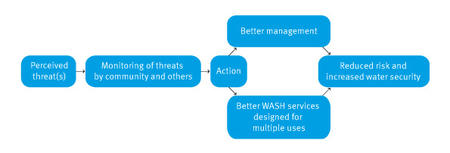All of the fresh water resources we depend on come from the natural environment. But a number of factors can combine to threaten water security, and force the world's poorest communities to drink dirty water.
WaterAid and water security
Three things are critical for water security: good-quality, well-managed water resources; well-managed water supply services; and management of disaster risk. Water resources cannot be easily accessed without pumps, pipes, taps, tanks and skilled people to manage them as part of a service. Similarly, water supply services alone are of little use without water resources. If disaster risk is not well managed, water supply services and water resources could be adversely affected. If services and water resources are unavailable or unreliable, and disaster risk is not managed, then people will not be water secure.
All of the fresh water resources we depend on come from the natural environment. Rain flows in rivers and is stored in lakes, the soil or vast underground layers of rock called aquifers. The quantity and quality of available water can vary over time because of changes in the natural environment or through the influence of human activity. Natural disasters also have an impact on the quantity and quality of available water as well as the continuity of services.
A number of factors can combine to threaten water security:
- Natural climate variability
- Human-induced climate change
- Population increases and migration
- Settlement of hazard-prone land
- Poor service provision
- Uncontrolled discharge of pollutants into water
- Exclusion because of caste, race, social status or political affiliation
Many of these threats can be managed to ensure that their impact is minimal, but often the political will and institutional capacity does not exist to do so. As a result, hundreds of millions of people remain without access to this basic human right.
Access to mobile phones versus clean water
According to a 2016 Afrobarometer survey covering 35 African countries, 93% of respondents said there was a mobile phone service in their area and only 63% said there was piped water. So why is piped water provision lagging behind?

Our approach
To improve people’s water security, we use a combination of different approaches:
- Helping people demand their right to clean water from governments
- Supporting service providers to meet the demand
- Bringing clean, reliable water supplies closer to people’s homes
- Supporting local governments and service providers to assist communities with the ongoing management, financing and technical aspects of keeping services running
- Working with national governments to strengthen processes and revenue streams
- Training users how to protect water from contamination
- Promoting technologies that can be operated, managed and financed by communities, with assistance from local government and service providers
- Promoting infrastructure and services that accommodate people’s different water needs – a ‘multiple use services' (MUS) approach
- Encouraging community investment in water supply services (‘self-supply’)
- Promoting the monitoring of water resources, to inform early warning systems for drought response and management, as well as equitable water use
- Strengthening the ability of communities and local governments to manage threats to their water supplies
It is not enough to simply deliver services and train users how to operate them. Institutions must be in place to help people keep their services running over time and adapt to changes in the water resources available to them. This requires expertise in service delivery and water resource management (WRM).
WaterAid is increasingly combining the delivery of water, sanitation and hygiene (WASH) services with improved water resource management. Our integrated WASH/WRM approach provides a structure for identifying and monitoring water-related threats, carrying out risk-based planning, and acting to mitigate these threats. The outcome is reduced risk and increased water security.
Our aim is to reduce the level of water-related risk that people face. This is achieved by strengthening the links between national government, local government and communities, complementing national strategies for water supply service delivery and water resource management.
Securing water resources in West Africa
One example of our approach to water security is an innovative method known as ‘securing water resources’ (SWR), which we’ve been implementing across our country programmes in West Africa.
This approach:
- Integrates WASH service delivery with the principles of water resource management
- Acts as an early warning system, alerting communities to emerging threats
- Provides a structure for community-level risk-based planning
- Informs the design of services to better meet multiple water needs
- Supports better coordination and fairer allocation of water between users
- Helps communities call on governments for assistance when their access to water is threatened
- Strengthens government support to communities
